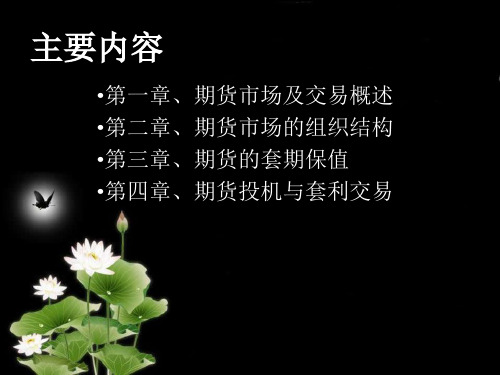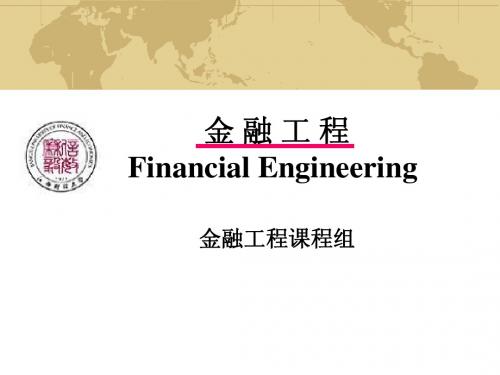国际期货市场运作7HedgingwithSpreads 共18页PPT资料
合集下载
期货基础知识学习课件PPT课件

现货交易的目的是获得或让渡实物商品或金融产品。期货 交易的主要目的,或者是为了规避现货市场价格波动的风 险,或者是利用现货市场的价格波动获得收益。
•授课:XXX
•8
(2)期货交易与远期现货交易---期货交易直接由远期
现货交易演变发展而来。远期现货交易与期货交易存在着 许多相似的外在表现形式,目前的远期现货交易往往也采 用集中交易、公开竞价、电子化交易等形式。因此,在现 实当中容易把远期现货交易与期货交易相混淆。
•授课:XXX
•20
(二)买入套期保值的应用
买入套期保值的操作主要适用于以下情形:
第一,预计在未来要购买某种商品或资产,购买价格尚未确 定时,担心市场价格上涨,使其购入成本提高。
第二,目前尚未持有某种商品或资产,但已按固定价格将该 商品或资产卖出(此时处于现货空头头寸),担心市场价 格上涨,影响其销售收益或者采购成本。例如,某商品的 生产企业,已按固定价格将商品销售,那么待商品生产出 来后,其销售收益就不能随市场价格上涨而增加。
•授课:XXX
•9
四、期货市场的功能与作用
(一)期货市场的功能
1、规避风险功能---是指期货市场能够规避现货价格 波动的风险。这是期货市场的参与者通过套期保
值交易实现的。企业如何套期保值呢?就是利用 期货市场的双向交易和对冲机制,在适当的时候 做反方向交易。
2、价格发现功能---根据期货市场的走向,可以预 测和指导现货市场价格的未来走向,使企业合理
(2)场内集中竞价交易---期货交易实行场内交易,所有买 卖指令必须在交易所内进行集中竞价成交。只有交易所的 会员方能进场交易,其他交易者只能委托交易所会员,由 其代理进行期货交易。
(3)保证金交易---期货交易实行保证金制度,
•授课:XXX
•8
(2)期货交易与远期现货交易---期货交易直接由远期
现货交易演变发展而来。远期现货交易与期货交易存在着 许多相似的外在表现形式,目前的远期现货交易往往也采 用集中交易、公开竞价、电子化交易等形式。因此,在现 实当中容易把远期现货交易与期货交易相混淆。
•授课:XXX
•20
(二)买入套期保值的应用
买入套期保值的操作主要适用于以下情形:
第一,预计在未来要购买某种商品或资产,购买价格尚未确 定时,担心市场价格上涨,使其购入成本提高。
第二,目前尚未持有某种商品或资产,但已按固定价格将该 商品或资产卖出(此时处于现货空头头寸),担心市场价 格上涨,影响其销售收益或者采购成本。例如,某商品的 生产企业,已按固定价格将商品销售,那么待商品生产出 来后,其销售收益就不能随市场价格上涨而增加。
•授课:XXX
•9
四、期货市场的功能与作用
(一)期货市场的功能
1、规避风险功能---是指期货市场能够规避现货价格 波动的风险。这是期货市场的参与者通过套期保
值交易实现的。企业如何套期保值呢?就是利用 期货市场的双向交易和对冲机制,在适当的时候 做反方向交易。
2、价格发现功能---根据期货市场的走向,可以预 测和指导现货市场价格的未来走向,使企业合理
(2)场内集中竞价交易---期货交易实行场内交易,所有买 卖指令必须在交易所内进行集中竞价成交。只有交易所的 会员方能进场交易,其他交易者只能委托交易所会员,由 其代理进行期货交易。
(3)保证金交易---期货交易实行保证金制度,
期货与期权交易第3讲

2021/3/6
整理ppt
2
套期保值操作的四大原则
交易方向相反 商品种类相同或相近 商品数量相等或相近 交易月份相同或相近 如:储运商购入小麦,欲贮存3个月后出售。
套期保值操作原则的说明
2021/3/6
整理ppt
3
套期保值操作原则
2021/3/6
购入 (10吨) 卖出3个月后到 期期货合约 (10吨)
2021/3/6
整理ppt
7
买进套期保值情况分析
现货市场
1月×日 28500元/t (目标成本)
5月×日买进铜2500t 28800元/t
现货亏损300元/ t
期货市场
买进6月铜期货2500t 28700元/t
卖出6月铜期货2500t 29000 元/t
期货盈利300元/ t
2021/3/6
整理ppt
2021/3/6
整理ppt
5
套期保值的理论依据
套期保值之所以能有助于回避价格风 险,其基本原理就在于某一特定的期 货价格和现货价格同受相同的经济因 素影响和制约,在这种市场走势趋合 性的作用下,当期货合约到期时,现 货价格和期货价格基本相同 。
公理一 价格走势一致 公理二 价格到期聚合
2021/3/6
下面以谷物期货市场的大豆买期保值为例进行 分析。
2021/3/6
整理ppt
16
表1 持平保值
•
现货价格
卖:6.85 买:6.90 结果:-5
单位:美元/蒲式耳
期货价格 基差(美分)
买:6.90
-5
卖:6.95
-5
+5
0
• 在表1中,做套期保值之初,基差为-5,轧平头寸结束套期保值时,基 差仍为-5,于是,套期保值的结果是不赔不赚,现货市场的盈利与期货 市场的亏损正好相抵。
《期货市场技术分析》课件

详细描述
技术分析的应用与实践
PART
05
利用指标
许多技术指标可以帮助预测价格的转折点,如移动平均线、相对强弱指数(RSI)和动量指数等。这些指标可以提供关于市场动向的线索。
观察市场情绪
通过研究市场参与者的行为和市场情绪,可以判断市场的强弱和可能的转折点。例如,过度乐观或悲观的市场情绪可能预示着价格的反转。
总结词
期货市场是买卖期货合约的场所,与现货市场相比,期货市场具有高杠杆、高风险、高收益的特点。期货交易只需缴纳少量保证金,即可买入或卖出大量期货合约,因此具有高杠杆性。同时,期货价格波动较大,投资者需要承担较高的风险。然而,一旦获得成功,收益也会非常可观。
详细描述
总结词
期货市场具有价格发现、套期保值、规避风险等功能。
一定时间段内成交的合约数量,反映市场参与者的交易活跃度。
持仓量
未平仓的合约数量,反映市场参与者的持仓情况。
交易量
技术分析的主要理论
PART
04
道氏理论是技术分析的基石,它提供了一种理解市场趋势的方法。
道氏理论认为市场趋势是由主要的“牛市”和“熊市”周期驱动的,这些周期又由更小的次级周期和日常波动组成。理论强调了市场整体趋势的重要性,并提出了确认趋势反转的准则。
技术分析的基本理论
PART
02
总结词
技术分析是一种通过研究市场行为来预测未来价格变动的分析方法。它基于一些基本原则,如历史会重演、价格反映一切信息、趋势是朋友等。
详细描述
技术分析的定义是通过对市场价格、交易量等数据进行分析,以预测未来价格走势的方法。它基于一些基本原则,如市场行为反映一切信息、趋势是朋友、历史会重演等。这些原则认为,市场价格和交易量等数据包含了所有相关的信息,可以通过分析这些数据来预测未来的价格变动。
技术分析的应用与实践
PART
05
利用指标
许多技术指标可以帮助预测价格的转折点,如移动平均线、相对强弱指数(RSI)和动量指数等。这些指标可以提供关于市场动向的线索。
观察市场情绪
通过研究市场参与者的行为和市场情绪,可以判断市场的强弱和可能的转折点。例如,过度乐观或悲观的市场情绪可能预示着价格的反转。
总结词
期货市场是买卖期货合约的场所,与现货市场相比,期货市场具有高杠杆、高风险、高收益的特点。期货交易只需缴纳少量保证金,即可买入或卖出大量期货合约,因此具有高杠杆性。同时,期货价格波动较大,投资者需要承担较高的风险。然而,一旦获得成功,收益也会非常可观。
详细描述
总结词
期货市场具有价格发现、套期保值、规避风险等功能。
一定时间段内成交的合约数量,反映市场参与者的交易活跃度。
持仓量
未平仓的合约数量,反映市场参与者的持仓情况。
交易量
技术分析的主要理论
PART
04
道氏理论是技术分析的基石,它提供了一种理解市场趋势的方法。
道氏理论认为市场趋势是由主要的“牛市”和“熊市”周期驱动的,这些周期又由更小的次级周期和日常波动组成。理论强调了市场整体趋势的重要性,并提出了确认趋势反转的准则。
技术分析的基本理论
PART
02
总结词
技术分析是一种通过研究市场行为来预测未来价格变动的分析方法。它基于一些基本原则,如历史会重演、价格反映一切信息、趋势是朋友等。
详细描述
技术分析的定义是通过对市场价格、交易量等数据进行分析,以预测未来价格走势的方法。它基于一些基本原则,如市场行为反映一切信息、趋势是朋友、历史会重演等。这些原则认为,市场价格和交易量等数据包含了所有相关的信息,可以通过分析这些数据来预测未来的价格变动。
《期货交易》教学课件PPT教学

主要是为了获取风险利润。
包括趋势跟踪法和反趋势法。
是指根据市场趋势进行买入或卖出操作。当市场价格处于上升趋势时,买入;当市场价格处于下降趋势时,卖出。
是指根据市场反转的可能性进行买入或卖出操作。当市场价格处于高位,反转可能性较大时,卖出;当市场价格处于低位,反转可能性较大时,买入。
单边交易策略
作用
趋势跟踪法
解释
期货交易的定义
1
期货交易的特点
2
3
期货交易具有高杠杆效应,投资者只需支付一定比例的保证金即可进行交易。
杠杆效应
期货交易既可以做多也可以做空,即投资者可以买入或卖出期货合约。
双向交易
期货交易在期货交易所内进行,具有较高的流动性和透明度。
集中交易
期货交易的基本制度
期货交易实行保证金制度,投资者需在交易所账户中存入一定比例的保证金作为履约担保。
交易前准备
包括了解期货市场的基本情况、熟悉期货合约的规则和特点、学习期货交易的技术分析方法等。
开户与交易前准备
下单
根据分析结果,投资者在交易时间内通过期货公司的交易系统下达交易指令,包括买入或卖出期货合约、合约的月份、数量和价格等。
竞价
在规定的交易时间内,多个投资者之间进行竞价,形成期货合约的成交价格。
案例二:某投资者单边交易策略的成功案例
案例三
该公司运用期货市场进行风险管理,有效地降低了经营风险,提高了业绩稳定性。
总结词
某公司是一家贸易型企业,面临着库存商品价格波动的风险。为了降低经营风险,该公司运用期货市场进行风险管理,通过买入相应的期货合约来对冲价格波动的风险。通过这种方式,该公司有效地降低了经营风险,提高了业绩稳定性。
详细描述
该投资者在期货交易中遭遇了风险,但通过及时的止损和调整策略,成功地挽回了损失。
包括趋势跟踪法和反趋势法。
是指根据市场趋势进行买入或卖出操作。当市场价格处于上升趋势时,买入;当市场价格处于下降趋势时,卖出。
是指根据市场反转的可能性进行买入或卖出操作。当市场价格处于高位,反转可能性较大时,卖出;当市场价格处于低位,反转可能性较大时,买入。
单边交易策略
作用
趋势跟踪法
解释
期货交易的定义
1
期货交易的特点
2
3
期货交易具有高杠杆效应,投资者只需支付一定比例的保证金即可进行交易。
杠杆效应
期货交易既可以做多也可以做空,即投资者可以买入或卖出期货合约。
双向交易
期货交易在期货交易所内进行,具有较高的流动性和透明度。
集中交易
期货交易的基本制度
期货交易实行保证金制度,投资者需在交易所账户中存入一定比例的保证金作为履约担保。
交易前准备
包括了解期货市场的基本情况、熟悉期货合约的规则和特点、学习期货交易的技术分析方法等。
开户与交易前准备
下单
根据分析结果,投资者在交易时间内通过期货公司的交易系统下达交易指令,包括买入或卖出期货合约、合约的月份、数量和价格等。
竞价
在规定的交易时间内,多个投资者之间进行竞价,形成期货合约的成交价格。
案例二:某投资者单边交易策略的成功案例
案例三
该公司运用期货市场进行风险管理,有效地降低了经营风险,提高了业绩稳定性。
总结词
某公司是一家贸易型企业,面临着库存商品价格波动的风险。为了降低经营风险,该公司运用期货市场进行风险管理,通过买入相应的期货合约来对冲价格波动的风险。通过这种方式,该公司有效地降低了经营风险,提高了业绩稳定性。
详细描述
该投资者在期货交易中遭遇了风险,但通过及时的止损和调整策略,成功地挽回了损失。
Chapter 7 Hedging with Spreads 国际期货市场运作(英文 教学课件)

Hedging involves taking a position in the futures market that is opposite to the position held in the cash or spot market.
Selling Hedge
If a businessperson buys a commodity in the cash market, he or she would then hedge that position by selling an equivalent quantity in the futures market.
Chapter 7 Hedging with Spreads
What is hedging?
When a businessperson uses the futures market to protect against adverse price movements, the process is called hedging.
This is a technique that can not only complicate matters but also increase the risk of losses.
A Market Order Is Advisable
If an ideal opportunity to enter or to exit a given spread has been missed;
As the term implies, this technique involves entering a spread one side, or leg, at a time or exiting a spread one side, or leg, at a time.
Selling Hedge
If a businessperson buys a commodity in the cash market, he or she would then hedge that position by selling an equivalent quantity in the futures market.
Chapter 7 Hedging with Spreads
What is hedging?
When a businessperson uses the futures market to protect against adverse price movements, the process is called hedging.
This is a technique that can not only complicate matters but also increase the risk of losses.
A Market Order Is Advisable
If an ideal opportunity to enter or to exit a given spread has been missed;
As the term implies, this technique involves entering a spread one side, or leg, at a time or exiting a spread one side, or leg, at a time.
期货基础知识分享ppt

经济增长、通货膨胀、 利率、汇率等宏观经济 因素对期货价格有重要
影响。
政策因素
政策变化如货币政策、 财政政策等对期货价格
有直接影响。
行业动态
相关行业的生产状况、 库存情况、销售情况等 对特定期货品种的价格
有直接影响。
期货价格的技术面分析
K线图
通过分析K线图的形态、趋势和交易 量,可以判断期货价格的走势。
作用
期货市场能够为投资者提供更多元化 的投资选择,帮助企业规避价格波动 风险,促进金融市场的稳定和经济发 展。
02
期货交易制度
期货合约的构成和标准
交易品种
期货合约的交易品种包括商品 、金融产品等,每种交易品种
都有其特定的规格和标准。
交易单位
期货合约的交易单位通常较大 ,以适应大规模交易的需求。
报价方式
ABCD
多样化投资组合
通过投资组合的多样化,降低单一资产的风险, 提高整体投资组合的稳定性。
定期评估和调整投资组合
定期评估投资组合的表现和风险状况,及时调整 投资策略和组合结构。
期货市场的风险处置和应对
及时止损
一旦达到止损点,投资者应果断平仓或减仓, 避免亏损进一步扩大。
学习和研究
不断学习和研究市场动态、政策变化等,提 高自身投资水平和风险意识。
杠杆风险
期货交易通常采用杠杆交易方式,即以较 小的保证金进行较大规模的交易,这使得 投资者面临较大的亏损风险。
期货市场的风险控制和防范
制定风险管理计划
在进行期货交易之前,投资者应制定详细的风险 管理计划,明确风险承受能力、止损点等。
合理使用杠杆
根据自身风险承受能力和投资目标,合理选择杠 杆比例,避免过度杠杆化。
影响。
政策因素
政策变化如货币政策、 财政政策等对期货价格
有直接影响。
行业动态
相关行业的生产状况、 库存情况、销售情况等 对特定期货品种的价格
有直接影响。
期货价格的技术面分析
K线图
通过分析K线图的形态、趋势和交易 量,可以判断期货价格的走势。
作用
期货市场能够为投资者提供更多元化 的投资选择,帮助企业规避价格波动 风险,促进金融市场的稳定和经济发 展。
02
期货交易制度
期货合约的构成和标准
交易品种
期货合约的交易品种包括商品 、金融产品等,每种交易品种
都有其特定的规格和标准。
交易单位
期货合约的交易单位通常较大 ,以适应大规模交易的需求。
报价方式
ABCD
多样化投资组合
通过投资组合的多样化,降低单一资产的风险, 提高整体投资组合的稳定性。
定期评估和调整投资组合
定期评估投资组合的表现和风险状况,及时调整 投资策略和组合结构。
期货市场的风险处置和应对
及时止损
一旦达到止损点,投资者应果断平仓或减仓, 避免亏损进一步扩大。
学习和研究
不断学习和研究市场动态、政策变化等,提 高自身投资水平和风险意识。
杠杆风险
期货交易通常采用杠杆交易方式,即以较 小的保证金进行较大规模的交易,这使得 投资者面临较大的亏损风险。
期货市场的风险控制和防范
制定风险管理计划
在进行期货交易之前,投资者应制定详细的风险 管理计划,明确风险承受能力、止损点等。
合理使用杠杆
根据自身风险承受能力和投资目标,合理选择杠 杆比例,避免过度杠杆化。
[学习]投资学PPT课件第二十二章期货市场
![[学习]投资学PPT课件第二十二章期货市场](https://img.taocdn.com/s3/m/853230aaba0d4a7303763a3f.png)
• 期货合约要求以预定的价格交付标的资产 。
• 期货价格– 标的资产的价格是现在决定的 ,但在将来某一时期交付。
• 期货合约规定了标的资产的数量质量和交 割方式。
期货合约基本知识
• 多头头寸– 在交割日购买商品 • 空头头寸– 在合约到期日出售商品 • 期货合约是保证金交易。 • 在合同签订时,资金并没有易手。
交易策略
投机
• 从价格变动中获利
• 做空 – 认为价格会下跌 • 做多 - 认为价格会上涨
套期保值
• 规避价格波动带来的风险
– 多头套期保值- 规避资产购 买价格上涨的风险
– 多头套期保值-规避资产卖 出价格下跌的风险
基差与基差风险
• 基差- 期货价格与现货价格的价差,FT – PT
• 在合约到期日,收敛性决定了FT – PT= 0。
现货-期货平价定理
• 在完全的套期保值下,期货的收益是一 定的,不存在风险。
• 完全套期保值股票组合的收益率是无风 险收益率。
• 这种关系可以用于建立期货定价关系。
套期保值的例子
• 某投资者投资1000 美元于以标准普尔 500指数为标的物的指数共同基金。
• 假设该指数基金每年年底支付给投资者 20美元的股利。
期货合约基本知识
• 多头的利润= 到期日现货价格- 现时期货价格 • 空头的利润= 现时期货价格- 到期日现货价格
• 期货是零和博弈,所有的总损益是零。
图22.2 期货和期权合约买卖双方的利润
从图22.2数据中得出的结论
• 当到期日现货价格PT 等于现时的期货价格 F0时,利润为零。
• 与看涨期权不同,期货的多头的收益有可 能是负的,因为如果没有利润时,期货合 约的交易者不可能选择不执行合约。
• 期货价格– 标的资产的价格是现在决定的 ,但在将来某一时期交付。
• 期货合约规定了标的资产的数量质量和交 割方式。
期货合约基本知识
• 多头头寸– 在交割日购买商品 • 空头头寸– 在合约到期日出售商品 • 期货合约是保证金交易。 • 在合同签订时,资金并没有易手。
交易策略
投机
• 从价格变动中获利
• 做空 – 认为价格会下跌 • 做多 - 认为价格会上涨
套期保值
• 规避价格波动带来的风险
– 多头套期保值- 规避资产购 买价格上涨的风险
– 多头套期保值-规避资产卖 出价格下跌的风险
基差与基差风险
• 基差- 期货价格与现货价格的价差,FT – PT
• 在合约到期日,收敛性决定了FT – PT= 0。
现货-期货平价定理
• 在完全的套期保值下,期货的收益是一 定的,不存在风险。
• 完全套期保值股票组合的收益率是无风 险收益率。
• 这种关系可以用于建立期货定价关系。
套期保值的例子
• 某投资者投资1000 美元于以标准普尔 500指数为标的物的指数共同基金。
• 假设该指数基金每年年底支付给投资者 20美元的股利。
期货合约基本知识
• 多头的利润= 到期日现货价格- 现时期货价格 • 空头的利润= 现时期货价格- 到期日现货价格
• 期货是零和博弈,所有的总损益是零。
图22.2 期货和期权合约买卖双方的利润
从图22.2数据中得出的结论
• 当到期日现货价格PT 等于现时的期货价格 F0时,利润为零。
• 与看涨期权不同,期货的多头的收益有可 能是负的,因为如果没有利润时,期货合 约的交易者不可能选择不执行合约。
期货市场(第三章幻灯片PPT

目的: 为了避免将来买进商品时价格上涨的风险
适用者: 经销商、加工商、进口商
【例1】 9月份,某油厂预计11月份需要100吨大 豆作为原料。当时大豆的现货价格为每吨2010元, 该油厂对该价格比较满意。据预测11月份大豆价格可 能上涨,因此该油厂为了避免将来价格上涨,导致原 材料成本上升的风险,决定在大连商品交易所进行大 豆套期保值交易。
做基差交易,情况如下:
时间 现货市场
期货市场 基差
7月份 每蒲式耳5.1美 买进:每蒲式 -5美分
元
耳5.15美元
9月15日
购买现货:每 卖出:每蒲式 蒲式耳8.94美 耳9美元 元
-6美 分
结果
-3.84美元 +3.85美元 达到了控制进价的目的
变小
4、 双向叫价:
可同时作买方叫价和卖方叫价交易。
二、多选题 1、下列哪些属于正向市场? B C
A、期货价格低于现货价格 B、期货价格高于现货价格 C、近期月份合约价格低于远期月份合约价格 D 、近期月份合约价格高于远期月份合约价格
6、交易和交割月份相同或相近的原则。
三、套期保值交易的基本方法
(一)、卖期保值:
为了防止现货价格在交割时下跌的风险而先在期货市场 卖出与现货同样数量的合约所进行的交易方式。
目的:为了锁住销售价格。
适用者:初级产品的供应者,例如:农民、
农场主、矿业主、储运商等。
【例1】7月份,大豆的现货价格为每吨2010元,某 农场对该价格比较满意,但是大豆9月份才能出售, 因此该单位担心到时现货价格可能下跌,从而减少收 益。为了避免将来价格下跌带来的风险,该农场决定 在大连商品交易所进行大豆期货交易。交易情况如下 表所示:
(一)、涵义: 是指某一特定商品在某一特定时间和地点 的现货价格与该商品在期货市场的期货价格之差。 即 基差=现货价格-期货价格。
适用者: 经销商、加工商、进口商
【例1】 9月份,某油厂预计11月份需要100吨大 豆作为原料。当时大豆的现货价格为每吨2010元, 该油厂对该价格比较满意。据预测11月份大豆价格可 能上涨,因此该油厂为了避免将来价格上涨,导致原 材料成本上升的风险,决定在大连商品交易所进行大 豆套期保值交易。
做基差交易,情况如下:
时间 现货市场
期货市场 基差
7月份 每蒲式耳5.1美 买进:每蒲式 -5美分
元
耳5.15美元
9月15日
购买现货:每 卖出:每蒲式 蒲式耳8.94美 耳9美元 元
-6美 分
结果
-3.84美元 +3.85美元 达到了控制进价的目的
变小
4、 双向叫价:
可同时作买方叫价和卖方叫价交易。
二、多选题 1、下列哪些属于正向市场? B C
A、期货价格低于现货价格 B、期货价格高于现货价格 C、近期月份合约价格低于远期月份合约价格 D 、近期月份合约价格高于远期月份合约价格
6、交易和交割月份相同或相近的原则。
三、套期保值交易的基本方法
(一)、卖期保值:
为了防止现货价格在交割时下跌的风险而先在期货市场 卖出与现货同样数量的合约所进行的交易方式。
目的:为了锁住销售价格。
适用者:初级产品的供应者,例如:农民、
农场主、矿业主、储运商等。
【例1】7月份,大豆的现货价格为每吨2010元,某 农场对该价格比较满意,但是大豆9月份才能出售, 因此该单位担心到时现货价格可能下跌,从而减少收 益。为了避免将来价格下跌带来的风险,该农场决定 在大连商品交易所进行大豆期货交易。交易情况如下 表所示:
(一)、涵义: 是指某一特定商品在某一特定时间和地点 的现货价格与该商品在期货市场的期货价格之差。 即 基差=现货价格-期货价格。
金融工程 第2章 PPT 期货市场的运作机制

Page 19
2.4 每日结算与保证金的运作
投资者 多头
建立保 证金账户 存入 初始保证金 盈利
期货价格 上涨
经 纪 人
是 是否追加了 变动保证金 平仓
每日结算
期货价格 下跌
无需追加 保证金
亏损
账户资金 是否少于 维持保证金
否 保证金催付 经纪人
否
是
2.4 每日结算与保证金的运作
日 期货 价格 日期 (US$) 600.00 5-Jun . . . 13-Jun . . . 19-Jun . . . 597.00 . . . 593.30 . . . 587.00 . . . (600) . . . (420) . . . (1,140) . . . (600) . . . (1,340) . . . (2,600) . . . 收益 (损失) (US$) 累积 收益 (亏损) (US$) 保证金 帐户 余额 (US$) 4,000 3,400 . . . 2,660 . . . 2,740 . . . 0 . . . 保证金 催付 (US$)
2.3 期货价格收敛的即期价格的特性
图2-1 随着交割日接近,期货价格与即期价格之间的关系
Page 19
2.4 每日结算与保证金的运作
2.4.1 保证金的运作过程(P19) 例:假定一个投资者在6月5日星期四与其经纪人联系, 他准备买入2份纽约商品交易所12月份到期的黄金期货 合约,假设期货合约的当前价格为每盎司 600美元, 合约规模为100盎司黄金,投资者想以这一约定价格买 入200盎司黄金。 名义价值: 600x200=120000 初始保证金:4000 维持保证金:3000
不及时平仓给交易员带来的后果
Page 16
- 1、下载文档前请自行甄别文档内容的完整性,平台不提供额外的编辑、内容补充、找答案等附加服务。
- 2、"仅部分预览"的文档,不可在线预览部分如存在完整性等问题,可反馈申请退款(可完整预览的文档不适用该条件!)。
- 3、如文档侵犯您的权益,请联系客服反馈,我们会尽快为您处理(人工客服工作时间:9:00-18:30)。
Hedging involves taking a position in the futures market that is opposite to the position held in the cash or spot market.
Selling Hedge
If a businessperson buys a commodity in the cash market, he or she would then hedge that position by selling an equivalent quantity in the futures market.
Why Trade Spreads?
1. Spreads are often very reliable from the standpoint of seasonality.
2. Spread margins are generally very low or even zero. 3. Some (but not all) spreads are lower in risk than
either long or short positions. 4. There are a number of good timing indicators for
entering and exiting spreads.
Margin Requirements on Spreads
Many intracommodity spreads have extremely low margins.
This person is said to be short the cash market and so would take a long position in the futures market (be a buyer).
Conclusion:
Hedging not only protects against the possible losses from adverse price movement; it also takes away the possibility of windfall profits that can accrue as the result of favorable price moves.
March Futures Basis
November $5.30/bushel $5.47/bushel $-0.17
February $5.10/bushel $5.22/bushel $-0.12
Gain or Loss $-0.20
$-0.15
—————————————————————————
if a stop point has been penetrated and it is important to exit the market immediately;
In other words, there is no specific margin on these spreads.
Legging In and Legging Out
A common but not necessarily wise procedure for spread entry and exit is the legging in and legging out procedure.
This is a technique that can not only complicate matters but also increase the risk of losses.
A Market Order Is Advisable
If an ideal opportunity to enter or to exit a given spread been missed;
The purchase of one futures delivery month against the sale of another futures delivery month of the same commodity;
SPREADS AND STRADDLES 套利和对冲
A spread can also apply to options. It involves buying one futures contract and selling another futures contract.
Because gains and losses occur only as the result of a change in the price difference – rather than as a result of a change in the overall level of futures prices - spreads are often considered more conservative and less risky than having an outright long or short futures position .
As the term implies, this technique involves entering a spread one side, or leg, at a time or exiting a spread one side, or leg, at a time.
Legging In and Legging Out
There are two types of spreads
1. Intra-commodity Spread 2. Intercommodity Spread
TRADING SPREADS
Profits in spread trading are made in one of three ways
Buying Hedge
The buying hedge is used by a businessperson who anticipates buying a commodity at a future date and wants protection from a possible price increase.
The Basis 基差
The difference between the futures price and the spot price is known as the basis.
Base Example
_____________________________________
Date
Cash
SPREADS AND STRADDLES (套利和对冲)
A spread is simply the simultaneous buying of one contract and selling of another.
The price difference between two related markets or commodities.
Chapter 7 Hedging with Spreads
What is hedging?
When a businessperson uses the futures market to protect against adverse price movements, the process is called hedging.
The purpose is to profit from an unexpected
change in the relationship between the purchase
price of one and the selling price of the other.
SPREADS AND STRADDLES 套利和对冲
Selling Hedge
If a businessperson buys a commodity in the cash market, he or she would then hedge that position by selling an equivalent quantity in the futures market.
Why Trade Spreads?
1. Spreads are often very reliable from the standpoint of seasonality.
2. Spread margins are generally very low or even zero. 3. Some (but not all) spreads are lower in risk than
either long or short positions. 4. There are a number of good timing indicators for
entering and exiting spreads.
Margin Requirements on Spreads
Many intracommodity spreads have extremely low margins.
This person is said to be short the cash market and so would take a long position in the futures market (be a buyer).
Conclusion:
Hedging not only protects against the possible losses from adverse price movement; it also takes away the possibility of windfall profits that can accrue as the result of favorable price moves.
March Futures Basis
November $5.30/bushel $5.47/bushel $-0.17
February $5.10/bushel $5.22/bushel $-0.12
Gain or Loss $-0.20
$-0.15
—————————————————————————
if a stop point has been penetrated and it is important to exit the market immediately;
In other words, there is no specific margin on these spreads.
Legging In and Legging Out
A common but not necessarily wise procedure for spread entry and exit is the legging in and legging out procedure.
This is a technique that can not only complicate matters but also increase the risk of losses.
A Market Order Is Advisable
If an ideal opportunity to enter or to exit a given spread been missed;
The purchase of one futures delivery month against the sale of another futures delivery month of the same commodity;
SPREADS AND STRADDLES 套利和对冲
A spread can also apply to options. It involves buying one futures contract and selling another futures contract.
Because gains and losses occur only as the result of a change in the price difference – rather than as a result of a change in the overall level of futures prices - spreads are often considered more conservative and less risky than having an outright long or short futures position .
As the term implies, this technique involves entering a spread one side, or leg, at a time or exiting a spread one side, or leg, at a time.
Legging In and Legging Out
There are two types of spreads
1. Intra-commodity Spread 2. Intercommodity Spread
TRADING SPREADS
Profits in spread trading are made in one of three ways
Buying Hedge
The buying hedge is used by a businessperson who anticipates buying a commodity at a future date and wants protection from a possible price increase.
The Basis 基差
The difference between the futures price and the spot price is known as the basis.
Base Example
_____________________________________
Date
Cash
SPREADS AND STRADDLES (套利和对冲)
A spread is simply the simultaneous buying of one contract and selling of another.
The price difference between two related markets or commodities.
Chapter 7 Hedging with Spreads
What is hedging?
When a businessperson uses the futures market to protect against adverse price movements, the process is called hedging.
The purpose is to profit from an unexpected
change in the relationship between the purchase
price of one and the selling price of the other.
SPREADS AND STRADDLES 套利和对冲
